Point-of-Care Blood Test Evaluated for Ebola Virus Disease
|
By LabMedica International staff writers Posted on 08 Apr 2015 |
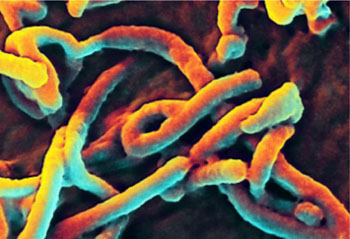
Image: Digitally-colorized scanning electron micrograph (SEM) of budding filamentous Ebolavirus particles (Photo courtesy of the US National Institute of Allergy and Infectious Diseases).
Current Ebolavirus disease (EVD) diagnosis relies on reverse transcription-polymerase chain reaction (RT-PCR) technology, requiring skilled laboratory personnel and technical infrastructure.
Lack of laboratory diagnostic capacity has led to diagnostic delays in the current West African EVD outbreak of 2014 and 2015, compromising outbreak control, with an estimated 24,701 cases and over 10,000 deaths.
Scientists at King's College London (UK) and their international colleagues evaluate the diagnostic accuracy of an EVD rapid diagnostic test (RDT) compared with the gold standard Ebola virus (EBOV) RT-PCR in an operational setting for EVD diagnosis of suspected EVD cases admitted to Ebola holding units (EHUs) in the Western Area of Sierra Leone. A total of 138 participants were enrolled and recruited consecutively at study sites, from January 22 to February 16, 2015.
The Defence Science and Technology Laboratory (DSTL; Porton Down, UK) have developed a rapid antigen diagnostic test (RDT) for EVD diagnosis. The DSTL EVD RDT is a bedside lateral flow assay using capillary blood rather than venous blood to detect presence of an undisclosed Ebolavirus antigen. The test can be conducted and interpreted with minimal training and the result is obtained within 20 minutes. A semi-quantitative result is obtained by scoring a test line on color intensity. The EVD RT-PCR testing was performed on venipuncture blood samples with the Altona RealStar Filovirus screen kit for RT-PCR (Altona Diagnostics; Hamburg, Germany).
Fifteen of 131 patients tested positive for EVD by EVD RT-PCR, giving a study EVD prevalence of 11.5%. All EVD cases were identified by a positive RDT with a test line score of six or more, giving a sensitivity of 100% and the corresponding specificity was high at 96.6%. The positive and negative predictive values for the population prevalence were 79.0% and 100%, respectively. The authors concluded that the DSTL EVD RDT is highly sensitive, specific and performs well in an operational setting. A high sensitivity is critical to EVD diagnostic test acceptability.
A highly sensitive screening test such as this would allow high-risk suspected EVD cases to be prioritized for isolation and confirmatory diagnostic testing with RT-PCR, reducing non-EVD admissions in EHUs. If the sensitivity was lower, EVD-positive cases could be inappropriately discharged to inpatient wards, with risks of onward nosocomial transmission. This RDT could be used as a “rule-out” screening test for EVD to improve rapid case identification and resource allocation. The study was published on March 16, 2015, in the journal Eurosurveillance.
Related Links:
King's College London
Defence Science and Technology Laboratory
Altona Diagnostics
Lack of laboratory diagnostic capacity has led to diagnostic delays in the current West African EVD outbreak of 2014 and 2015, compromising outbreak control, with an estimated 24,701 cases and over 10,000 deaths.
Scientists at King's College London (UK) and their international colleagues evaluate the diagnostic accuracy of an EVD rapid diagnostic test (RDT) compared with the gold standard Ebola virus (EBOV) RT-PCR in an operational setting for EVD diagnosis of suspected EVD cases admitted to Ebola holding units (EHUs) in the Western Area of Sierra Leone. A total of 138 participants were enrolled and recruited consecutively at study sites, from January 22 to February 16, 2015.
The Defence Science and Technology Laboratory (DSTL; Porton Down, UK) have developed a rapid antigen diagnostic test (RDT) for EVD diagnosis. The DSTL EVD RDT is a bedside lateral flow assay using capillary blood rather than venous blood to detect presence of an undisclosed Ebolavirus antigen. The test can be conducted and interpreted with minimal training and the result is obtained within 20 minutes. A semi-quantitative result is obtained by scoring a test line on color intensity. The EVD RT-PCR testing was performed on venipuncture blood samples with the Altona RealStar Filovirus screen kit for RT-PCR (Altona Diagnostics; Hamburg, Germany).
Fifteen of 131 patients tested positive for EVD by EVD RT-PCR, giving a study EVD prevalence of 11.5%. All EVD cases were identified by a positive RDT with a test line score of six or more, giving a sensitivity of 100% and the corresponding specificity was high at 96.6%. The positive and negative predictive values for the population prevalence were 79.0% and 100%, respectively. The authors concluded that the DSTL EVD RDT is highly sensitive, specific and performs well in an operational setting. A high sensitivity is critical to EVD diagnostic test acceptability.
A highly sensitive screening test such as this would allow high-risk suspected EVD cases to be prioritized for isolation and confirmatory diagnostic testing with RT-PCR, reducing non-EVD admissions in EHUs. If the sensitivity was lower, EVD-positive cases could be inappropriately discharged to inpatient wards, with risks of onward nosocomial transmission. This RDT could be used as a “rule-out” screening test for EVD to improve rapid case identification and resource allocation. The study was published on March 16, 2015, in the journal Eurosurveillance.
Related Links:
King's College London
Defence Science and Technology Laboratory
Altona Diagnostics
Latest Molecular Diagnostics News
- Advanced Liquid Biopsy Technology Detects Cancer Earlier Than Conventional Methods
- Blood-Based Test Outperforms Ultrasound in Early Liver Cancer Detection
- Four-In-One Molecular Test Detects and Differentiates Among Most Prevalent Respiratory Viruses in 20 Minutes
- First-Line PSA Testing More Cost-Effective Than First-Line MRI for Prostate Cancer Screening
- Proteomics Platform Identifies Proteins in Blood to Give Cancer Warning 7 Years before Diagnosis
- AI Technology-Based Blood Test Identifies Lung Cancer Earlier
- Ultra-Sensitive Blood Test Predicts Breast Cancer Recurrence Months or Even Years before Relapse
- Prenatal Testing Offers Window for Finding Mother’s Cancer Risk
- New Molecular Test Detects More Cervical Cancer Cases
- New Panel Quickly and Accurately Identifies 16 Common Gastrointestinal Pathogens
- New DNA Testing Method Offers Faster and More Accurate Pathogen Identification
- Precise Cancer Detection Method as Quick and Easy as Blood Test
- DNA Spit Test More Accurate At Identifying Future Prostate Cancer Risk
- Novel Method Combining Nano Informatics and AI Paves Way for Cancer Blood Tests
- Groundbreaking Molecular Diagnostic Kit to Provide Lyme Disease Detection in Minutes
- New Assay Detects Heart Failure Biomarker in Less than 11 Minutes
Channels
Clinical Chemistry
view channel
New ADLM Guidance Provides Expert Recommendations on Clinical Testing For Respiratory Viral Infections
Respiratory tract infections, predominantly caused by viral pathogens, are a common reason for healthcare visits. Accurate and swift diagnosis of these infections is essential for optimal patient management.... Read more
3D Printed Point-Of-Care Mass Spectrometer Outperforms State-Of-The-Art Models
Mass spectrometry is a precise technique for identifying the chemical components of a sample and has significant potential for monitoring chronic illness health states, such as measuring hormone levels... Read more.jpg)
POC Biomedical Test Spins Water Droplet Using Sound Waves for Cancer Detection
Exosomes, tiny cellular bioparticles carrying a specific set of proteins, lipids, and genetic materials, play a crucial role in cell communication and hold promise for non-invasive diagnostics.... Read more
Highly Reliable Cell-Based Assay Enables Accurate Diagnosis of Endocrine Diseases
The conventional methods for measuring free cortisol, the body's stress hormone, from blood or saliva are quite demanding and require sample processing. The most common method, therefore, involves collecting... Read moreMolecular Diagnostics
view channel
Advanced Liquid Biopsy Technology Detects Cancer Earlier Than Conventional Methods
Liquid biopsy technology has yet to fully deliver on its significant potential. Traditional methods have focused on a narrow range of cancer-associated mutations that are often present in such low quantities... Read more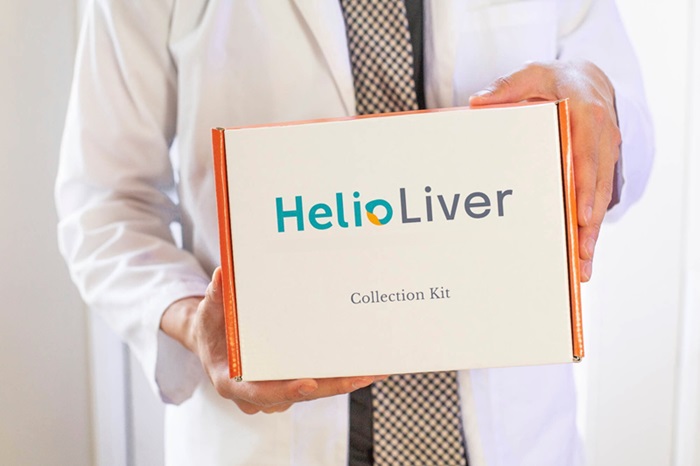
Blood-Based Test Outperforms Ultrasound in Early Liver Cancer Detection
Patients with liver cirrhosis and chronic hepatitis B are at a higher risk for developing hepatocellular carcinoma (HCC), the most prevalent type of liver cancer. The American Association for the Study... Read more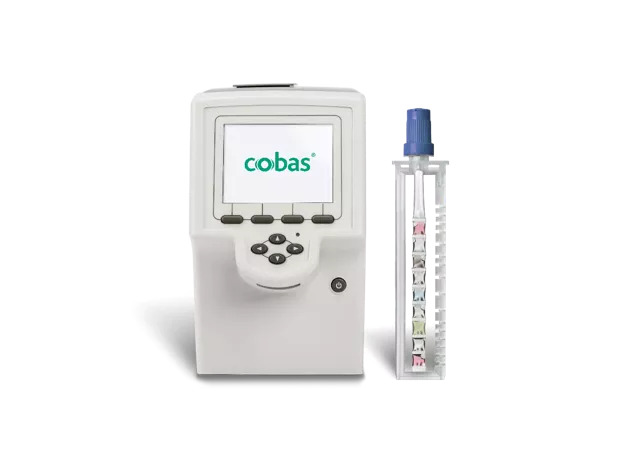
Four-In-One Molecular Test Detects and Differentiates Among Most Prevalent Respiratory Viruses in 20 Minutes
The U.S. Centers for Disease Control and Prevention (CDC) has reported that respiratory diseases in the United States reached high levels during the recent autumn and winter seasons, with SARS-CoV-2 leading... Read more.jpeg)
First-Line PSA Testing More Cost-Effective Than First-Line MRI for Prostate Cancer Screening
Current prostate cancer (PCa) screening protocols typically begin with prostate-specific antigen (PSA) testing, which, if elevated, may lead to further assessment using multiparametric magnetic resonance... Read moreHematology
view channel
Next Generation Instrument Screens for Hemoglobin Disorders in Newborns
Hemoglobinopathies, the most widespread inherited conditions globally, affect about 7% of the population as carriers, with 2.7% of newborns being born with these conditions. The spectrum of clinical manifestations... Read more
First 4-in-1 Nucleic Acid Test for Arbovirus Screening to Reduce Risk of Transfusion-Transmitted Infections
Arboviruses represent an emerging global health threat, exacerbated by climate change and increased international travel that is facilitating their spread across new regions. Chikungunya, dengue, West... Read more
POC Finger-Prick Blood Test Determines Risk of Neutropenic Sepsis in Patients Undergoing Chemotherapy
Neutropenia, a decrease in neutrophils (a type of white blood cell crucial for fighting infections), is a frequent side effect of certain cancer treatments. This condition elevates the risk of infections,... Read more
First Affordable and Rapid Test for Beta Thalassemia Demonstrates 99% Diagnostic Accuracy
Hemoglobin disorders rank as some of the most prevalent monogenic diseases globally. Among various hemoglobin disorders, beta thalassemia, a hereditary blood disorder, affects about 1.5% of the world's... Read moreImmunology
view channel.jpg)
AI Tool Predicts Cancer Patients’ Response to Immunotherapy
Immune checkpoint inhibitors are a form of immunotherapy drug that enables immune cells to target and destroy cancer cells. At present, the Food and Drug Administration has approved two predictive biomarkers... Read more
Molecular Profiling Improves Diagnosis for Children with High Risk Cancers
Cancer remains the leading cause of disease-related death among children in most developed nations, and approximately one-fourth of these patients are diagnosed with aggressive, high-risk, or relapsed... Read morePathology
view channel
New Technique Reveals Earliest Signs of Genetic Mutations
Mutations are alterations in the molecular "letters" that constitute the DNA code, which serves as the blueprint for all living cells. While some of these changes may be inconsequential, others can lead... Read more
New WHO Reporting System for Lung Cytopathology to Enhance Diagnostic Accuracy
Lung cancer continues to be the most common cause of cancer-related deaths worldwide and ranks as the second most frequently diagnosed cancer in both men and women. The role of lung cytopathology, which... Read more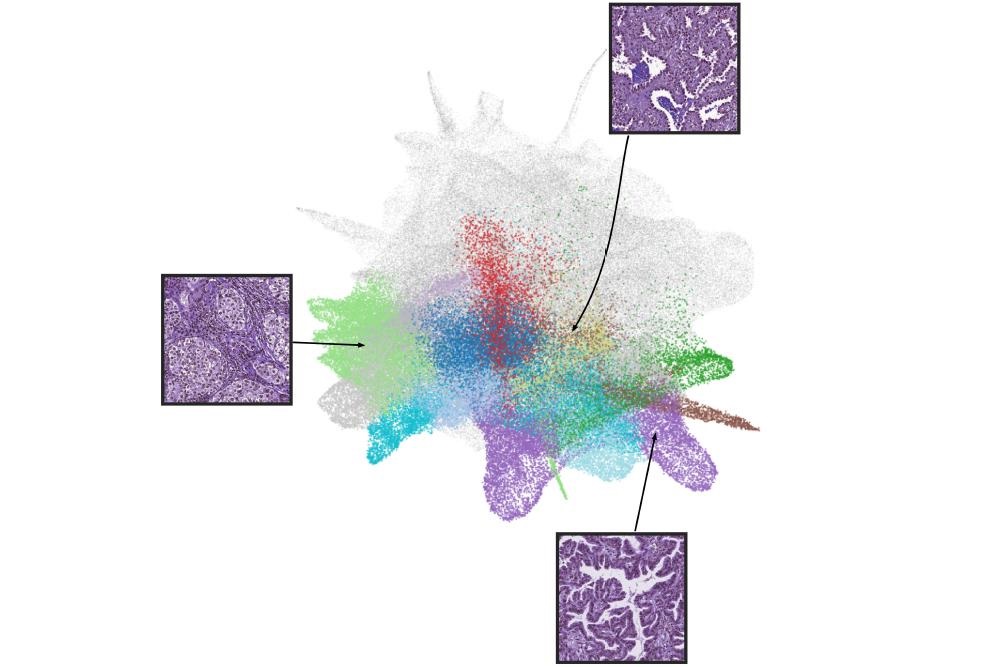
Self-Taught AI Tool Diagnoses and Predicts Severity of Common Lung Cancer
A computer program powered by artificial intelligence (AI) and trained on nearly half a million tissue images can effectively diagnose cases of adenocarcinoma, the most prevalent type of lung cancer.... Read more
Novel AI-Powered Method for Tissue Analysis Improves Understanding of Disease Pathology
Scientists at Brown University (Providence, RI, USA) and the University of Michigan (Ann Arbor, MI, USA) have created a groundbreaking computational technique to examine complex tissue data, potentially... Read moreTechnology
view channel
Microneedle Patch Detects Skin Cancer Early
Wearable bioelectronics has emerged as a significant innovation in healthcare, especially in the field of biosensing, providing a new method to monitor individual health for both diagnostic and therapeutic purposes.... Read more
New Diagnostic System Achieves PCR Testing Accuracy
While PCR tests are the gold standard of accuracy for virology testing, they come with limitations such as complexity, the need for skilled lab operators, and longer result times. They also require complex... Read moreIndustry
view channel
Roche and Hitachi High-Tech Extend 46-Year Partnership for Breakthroughs in Diagnostic Testing
Roche (Basel, Switzerland) and Hitachi High-Tech (Tokyo, Japan) have renewed their collaboration agreement, committing to a further 10 years of partnership. This extension brings together their long-standing... Read more
Danaher and Johns Hopkins University Collaborate to Improve Neurological Diagnosis
Unlike severe traumatic brain injury (TBI), mild TBI often does not show clear correlations with abnormalities detected through head computed tomography (CT) scans. Consequently, there is a pressing need... Read more
Beckman Coulter and MeMed Expand Host Immune Response Diagnostics Partnership
Beckman Coulter Diagnostics (Brea, CA, USA) and MeMed BV (Haifa, Israel) have expanded their host immune response diagnostics partnership. Beckman Coulter is now an authorized distributor of the MeMed... Read more_1.jpg)









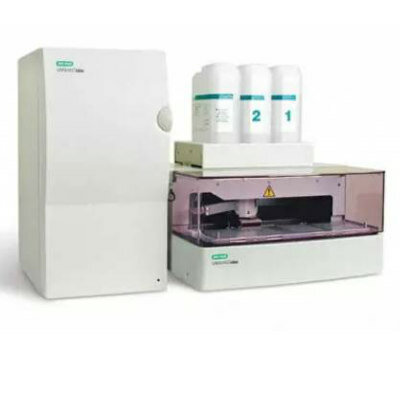


.jpg)


